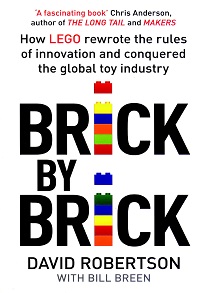I am interested in agile software development methods, LEAN management styles and the impact on a company’s organization. All these attributes are usually associated with software development companies – not hardware companies or toy companies.
I got a “must-read” recommendation for the book “brick by brick” by David Robertson.  The book proved to be a real “must-read”. Especially the portion where David Robertson describes the turnaround of the company. The methods applied to an almost bancrupt company reminded me to techniques nowadays well-known in software development teams. I mailed David Robertson and asked for permission to cite a portion of his book (page 170, Brick by Brick, David Robertson):
The book proved to be a real “must-read”. Especially the portion where David Robertson describes the turnaround of the company. The methods applied to an almost bancrupt company reminded me to techniques nowadays well-known in software development teams. I mailed David Robertson and asked for permission to cite a portion of his book (page 170, Brick by Brick, David Robertson):
Before the rise of Bionicle, the LEGO Group’s product teams were soloed from one another and toys were for the most part developed sequentially: designers mocked up the models and then threw their creations over a metaphorical wall to the engineers, who prepared the prototypes for manufacture and then kicked them over to the marketers, and so on down the line. Rarely would one team venture onto another team’s turf to offer a suggestion or ask for feedback. If all went well, the team’s product would hit the market in two or three years.
The Bionicle team’s six-month deadlines forced a different way of working, one that was less sequential than parallel, and highly collaborative. Once the outline for the next chapter of the Bionicle saga was roughed out, the different functional groups would work side by side in real time, swapping ideas, critiquing models, and always pushing to simultaneously nail the deadline and build a better Bionicle.
“We had a massive project team,” recalled Farshtey. “It wasn’t just the creative people; it was also people from Advance and from marketing, sales, events, PR – all different parts of the company, all helping to steer the franchise.”
Because the marketing group worked directly with designers, Bionicle’s advertising campaign felt connected to the product. Promotional posters for Bionicle’s first-year run had to look and feel of movie posters, precisely because the toy featured the powerful visuals and narrative sweep of an epic film. “We wanted more communication in the product and more product in the communication,” said Faber. “That meant the marketing group needed to be involved at the very start of product development, so the story flowed out through the product. We wanted the product almost to tell the story by itself.”
“We had a kind of triangle, where the marketing, the story, and the product had to move ahead together,” he continued. “None of those could be the spearhead. Each needed to support and inspire the other.”
That single page really got to a point. I’m relentlessly telling that the core of the agile movement is about focus and collaboration (see Agile Defined). Usually, I refer to these values in software development environments, organizations and teams. But LEGO – a brick & mortar company – used the same principles in 2001 to turnaround their company. That was really mind-boggling news to me.
After doing some research on this topic, I found a SMB here in Germany working with agile principles: HEMA Bandsägetechnik. This (german) article talks about their experience.

